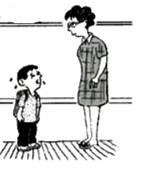|
A. What's the good news? B. First, you should speak English as often as you can. C. How did you do that? D. Finally, you should do a lot of exercises. E. That is Very hard. |
A: Mary, you look very happy.
B: I got a full mark in my English test.
A: That's great! I always have trouble with my English.
B: Well.
A: I'm too shy to speak English in front of others.
B: But it will help you a lot. Second, you should try to remember some sentences.
A:
B: Yes, it is hard in the beginning. But when you get used to it, it becomes easy. I believe you will do better in English.
A: Thanks for your advice.
B: You're welcome.

One Friday morning Chen Hua gets up late. When he gets to the door of the classroom, Mr. Gao, his math teacher says, "You are1again. Now how many times are you late this week?" "Three times." "Why are you late2class?" "Because I get up late." "Why don't you go to bed3?" asks the teacher.
"It isn't my fault(过错), Mr. Gao. The TV play is over4about eleven." answers Chen Hua." Now, please5me your homework." says the teacher.
"I'm sorry, I can't do it." "Why don't you do it?" asks the teacher.
"Because the first part of the homework is6easy. I don't think I need to do it. The second part is too difficult7me to do it. I can't8it out. So I don't do it."
Rules are like rulers they tell us what we should do. We use signs to talk about rules. There are four kinds of signs. They are warning signs, information signs, direction signs, instruction (指令)signs. We can find a 'No smoking' in the library. It means we mustn't smoke. We can find a 'No swimming' sign by a river or a pool. It tells us we can't swim here. An instruction sign tells us how to do or not to do something. A direction sign tells us where to go. Signs are very important for everyone. They tell us what we must or mustn't do. We should obey the signs. If there are no signs on the road, accidents will happen everywhere. So we should follow the signs.